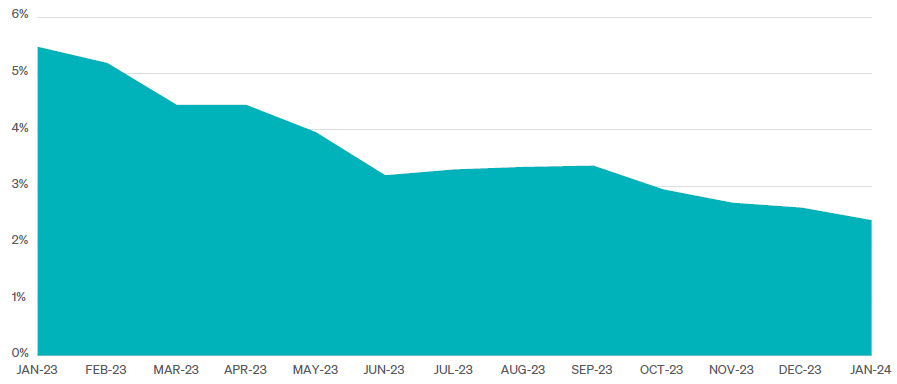March 2024
February 2024: Capital Markets Commentary
» U.S. Markets
» International
» The Federal Reserve
» Inflation
» Labor Market
» Business Activity
» International
» The Federal Reserve
» Inflation
» Labor Market
» Business Activity

Key Takeaways
U.S. Markets
Equity markets showed resilience in February, with the S&P 500 Index delivering an impressive +5.34%, propelling its year-to-date return to +7.11%. The S&P MidCap 400 Index outpaced large-cap indices, with a gain of +5.94% in February and increased its 2024 total return to 4.13%. Investors welcomed an increase in the number of companies participating in the rally and increasing market breadth. Small-cap stocks in the Russell 2000 Index achieved a monthly total return of 5.65%, bringing its year-to-date return into positive territory at 1.54%. This year's lag in small-cap performance reflects the challenge that smaller companies face in this higher-for-longer interest rate environment. Fixed income has had a challenging start to the year. The Bloomberg US Aggregate Bond Total Return Index declined -1.41% in February, extending its YTD loss to -1.68%. Rising interest rates and inflationary pressures continued to weigh on bond prices for fixed-income investors.
International
The performance of emerging market equities improved in February, as the MSCI Emerging Markets Index returned 4.76%, yet remained in negative territory for the year. Developed international stocks in the MSCI EAFE Index posted a modest gain of 1.83% for the month and a year-to-date return of 2.42%, signaling relatively subdued performance compared to their U.S. counterparts. Global markets grappled with various economic and geopolitical challenges, contributing to the divergence in performance between domestic and international equities.
The Federal Reserve
Jerome Powell provided reassurance at the Federal Reserve's Semiannual Monetary Policy report presented to Congress. Powell indicated that while the stock market reached new highs, the Fed believed its policy rate was likely at its peak for this tightening cycle. However, the Fed remains cautious about relaxing its monetary policy too soon, emphasizing the importance of sustainable inflation levels. Powell stated, "The Committee does not expect that it will be appropriate to reduce the target range until it has gained greater confidence that inflation is moving sustainably toward 2 percent."
It looks like investors are finally coming around to the Fed's outlook on the future of rate cuts. At the beginning of the year, the CME’s FedWatch tool showed that investors expected the FOMC to have six to seven interest rate cuts in 2024. However, after strong economic growth and continued caution from the Fed, they are currently only pricing in three rate cuts this year.
It looks like investors are finally coming around to the Fed's outlook on the future of rate cuts. At the beginning of the year, the CME’s FedWatch tool showed that investors expected the FOMC to have six to seven interest rate cuts in 2024. However, after strong economic growth and continued caution from the Fed, they are currently only pricing in three rate cuts this year.
Inflation
The January PCE results were released at the end of February and rose 0.4%, meeting market expectations. PCE is the Fed's preferred measure of inflation and continues to trend downward from its peak in June 2022. Inflation has decreased to a +2.4% year-over-year increase, a level not seen since 2021.
PCE PRICE INDEX ANNUAL CHANGE

SOURCE: U.S. BUREAU OF ECONOMIC ANALYSIS
Labor Market
According to the BLS, labor markets presented a mixed picture, as unemployment rose from 3.7% to 3.9% in February, reaching its highest level since January 2022. However, nonfarm payrolls were more optimistic and exceeded forecasts of adding 200,000 by adding 275,000 jobs.
Business Activity
The Institute for Supply Management presented a less optimistic picture. The ISM Services index dropped from 53.4 to 52.6, indicating a slight slowdown in the service sector's growth. More notably, the ISM Manufacturing index fell from 49.1 to 47.8, significantly below analyst expectations, signaling a contraction in manufacturing activity.
Equity markets showed resilience amid broader economic uncertainties, while bond markets faced challenges. With central bank policies and economic indicators influencing market sentiment, investors must remain vigilant, emphasizing the need for a balanced and diversified investment approach to navigate these evolving market conditions.
Equity markets showed resilience amid broader economic uncertainties, while bond markets faced challenges. With central bank policies and economic indicators influencing market sentiment, investors must remain vigilant, emphasizing the need for a balanced and diversified investment approach to navigate these evolving market conditions.
The views expressed herein are exclusively those of Meeder Investment Management, Inc., are not offered as investment advice, and should not be construed as a recommendation regarding the suitability of any investment product or strategy for an individual’s particular needs. Investment in securities entails risk, including loss of principal. Asset allocation and diversification do not assure a profit or protect against loss. There can be no assurance that any investment strategy will achieve its objectives, generate positive returns, or avoid losses.
Commentary offered for informational and educational purposes only. Opinions and forecasts regarding markets, securities, products, portfolios, or holdings are given as of the date provided and are subject to change at any time. No offer to sell, solicitation, or recommendation of any security or investment product is intended. Certain information and data has been supplied by unaffiliated third parties as indicated. Although Meeder believes the information is reliable, it cannot warrant the accuracy, timeliness or suitability of the information or materials offered by third parties.
Investment advisory services provided by Meeder Asset Management, Inc.
INDEX DESCRIPTIONS
S&P 500 Index: The Index tracks the stock performance of 500 of the largest companies listed on stock exchanges in the United States. It is one of the most followed equity indices and includes approximately 80% of the total market capitalization of U.S. public companies.
S&P 400 MidCap Index: The Index serves as a gauge for the U.S. mid-capequities sector and is the most widely followed mid-cap index. To be included in the index, a stock must have a total market capitalization that ranges from $5.8 billion to $15.8 billion.
Russell 2000 Index: The Index is constructed to provide a comprehensive, unbiased barometer of the small-cap segment of the US equity market. A subset of the Russell 3000 Index, it includes approximately 2,000 of the smallest securities based on a combination of their market cap and current index membership.
MSCI EAFE Index: The Index is an equity index that captures large and mid-cap representation across 21 Developed Markets countries* around the world, excluding the US and Canada. With 783 constituents, the index covers approximately 85% of the free float-adjusted market capitalization in each country.
MSCI EM Index: The Index captures large and mid-cap representation across 24 Emerging Markets (EM) countries*. With 1,440 constituents, the index covers approximately 85% of the free float-adjusted market capitalization in each country.
Bloomberg US Aggregate Bond Index: The Index is a broad-based flagship benchmark that measures the investment-grade, US dollardenominated, fixed-rate taxable bond market. The index includes Treasuries, government-related and corporate securities, fixed-rate agency MBS, ABS, and CMBS (agency and non-agency). Provided the necessary inclusion rules are met, US Aggregate-eligible securities also contribute to the multi-currency Global Aggregate Index and the US Universal Index. The US Aggregate Index was created in 1986, with history backfilled to January 1, 1976.
©2024 Meeder Investment Management, Inc.
0116-MAM-3/14/24-41274

Commentary offered for informational and educational purposes only. Opinions and forecasts regarding markets, securities, products, portfolios, or holdings are given as of the date provided and are subject to change at any time. No offer to sell, solicitation, or recommendation of any security or investment product is intended. Certain information and data has been supplied by unaffiliated third parties as indicated. Although Meeder believes the information is reliable, it cannot warrant the accuracy, timeliness or suitability of the information or materials offered by third parties.
Investment advisory services provided by Meeder Asset Management, Inc.
INDEX DESCRIPTIONS
S&P 500 Index: The Index tracks the stock performance of 500 of the largest companies listed on stock exchanges in the United States. It is one of the most followed equity indices and includes approximately 80% of the total market capitalization of U.S. public companies.
S&P 400 MidCap Index: The Index serves as a gauge for the U.S. mid-capequities sector and is the most widely followed mid-cap index. To be included in the index, a stock must have a total market capitalization that ranges from $5.8 billion to $15.8 billion.
Russell 2000 Index: The Index is constructed to provide a comprehensive, unbiased barometer of the small-cap segment of the US equity market. A subset of the Russell 3000 Index, it includes approximately 2,000 of the smallest securities based on a combination of their market cap and current index membership.
MSCI EAFE Index: The Index is an equity index that captures large and mid-cap representation across 21 Developed Markets countries* around the world, excluding the US and Canada. With 783 constituents, the index covers approximately 85% of the free float-adjusted market capitalization in each country.
MSCI EM Index: The Index captures large and mid-cap representation across 24 Emerging Markets (EM) countries*. With 1,440 constituents, the index covers approximately 85% of the free float-adjusted market capitalization in each country.
Bloomberg US Aggregate Bond Index: The Index is a broad-based flagship benchmark that measures the investment-grade, US dollardenominated, fixed-rate taxable bond market. The index includes Treasuries, government-related and corporate securities, fixed-rate agency MBS, ABS, and CMBS (agency and non-agency). Provided the necessary inclusion rules are met, US Aggregate-eligible securities also contribute to the multi-currency Global Aggregate Index and the US Universal Index. The US Aggregate Index was created in 1986, with history backfilled to January 1, 1976.
©2024 Meeder Investment Management, Inc.
0116-MAM-3/14/24-41274
